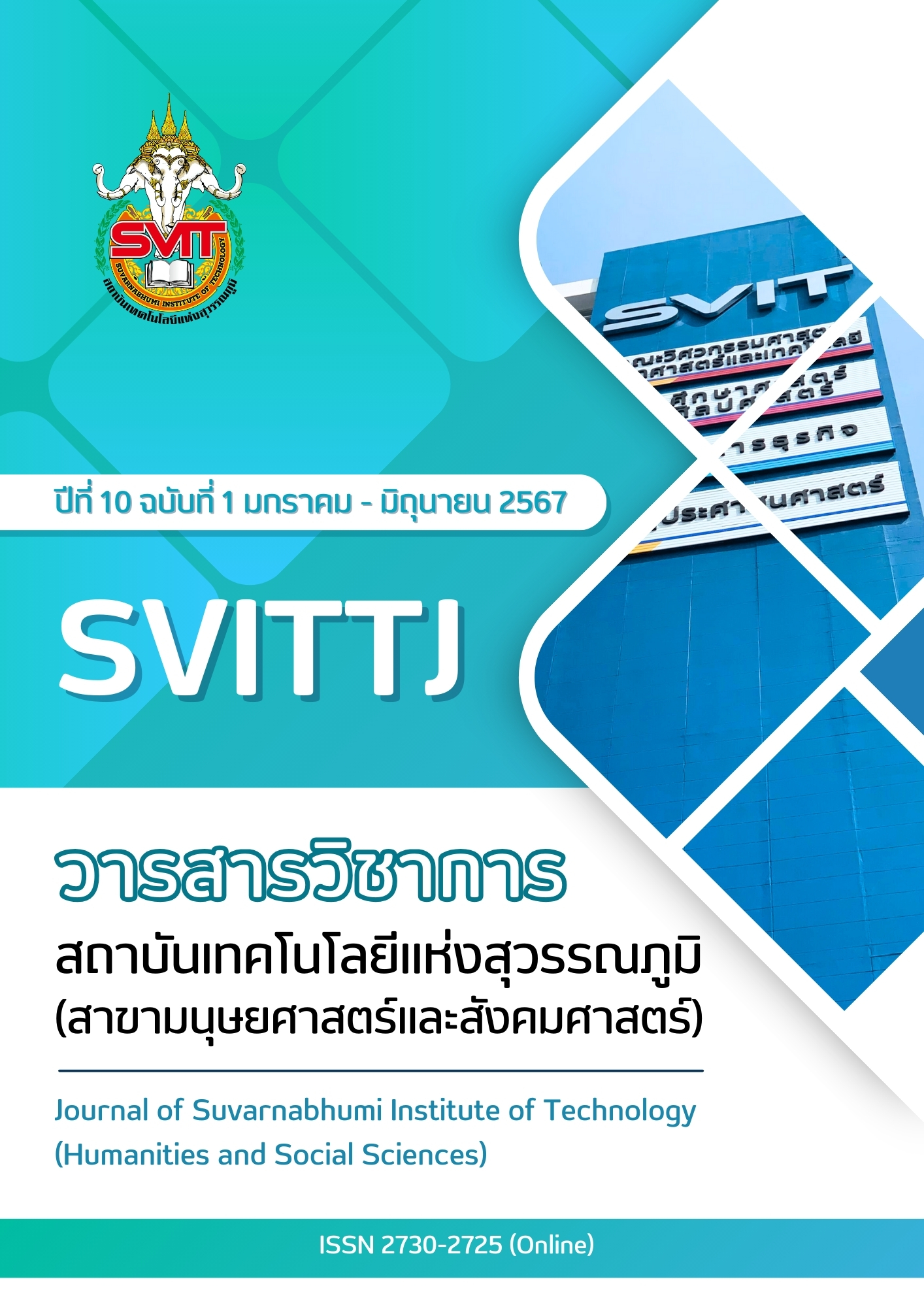STRATEGIES OF FUNERAL-THEMED PORRIDGE RESTAURANT ENTREPRENEURS: A VIEWPOINT FROM THE PRACTICE OF SEMIOLOGY
Keywords:
Business Strategies and Experiential Strategies, Modern Marketing, Funeral-Themed, Restaurant Business, SemiologyAbstract
This academic article examines the strategies used by funeral-themed porridge restaurant entrepreneurs to navigate the competitive restaurant industry and the pressures of consumer society. It explores how semiotics in modern marketing influence consumer perception and word-of-mouth communication, leading to societal trends and digital media coverage. In a Buddhist cultural context, the funeral theme—constructed through objects, images, and words—carries both explicit and implicit meanings that require cultural interpretation. The study shows that business and experiential strategies related to sign interpretation demonstrate society's role in shaping business practices. This leads to the efficient use of resources and the achievement of business goals in the modern restaurant industry.
References
กรมพัฒนาธุรกิจการค้า. (2562). ธุรกิจร้านอาหาร บทวิเคราะห์ธุรกิจประจำเดือนกุมภาพันธ์ 2562. สืบค้นจาก https://www.dbd.go.th/download/document_file/Statisic/2562/T26/T26_201902.pdf.
กาญจนา แก้วเทพ และ สมสุข หินวิมาน. (2553). สายธารแห่งนักคิดทฤษฎี เศรษฐศาสตร์การเมือง. กับสื่อการศึกษา. กรุงเทพฯ: ภาพพิมพ์.
ข่าวสดออนไลน์. (2562). เปิดใจเจ้าของร้าน ที่มาข้าวต้มงานศพ เคยฆ่าตัวตาย 2 ครั้ง ปลดหนี้ 10 ล้านใน 1 ปี. สืบค้นจาก https://www.khaosod.co.th/special-stories/news_2298171.
ความเชื่ออาหารงานศพ สืบหาความลึกลับกับ ‘เจ้าของร้านอาหารงานศพ วัดธาตุทอง’. (2562). สืบค้นจาก https://urbancreature.co/behind-funeral-food.
คมชัดลึก. (2562). "ข้าวต้มงานศพ" เปลี่ยนชีวิต...คนธรรมดา. สืบค้นจาก https://www.youtube.com/watch?v=hFslaZwYHGU.
จุฑามาศ พีรพัชระ สมนึก วิสุทธิแพทย์ ธีรวุฒิ บุณยโสภณ และทวีศักดิ์ รูปสิงห์. (2561). รูปแบบการพัฒนาศักยภาพผู้ประกอบการธุรกิจร้านอาหาร. วารสารวิชาการนวัตกรรมสื่อสารสังคม, 6,(12) ก.ค.-ธ.ค., 165-176.
ไชยรัตน์ เจริญสินโอฬาร. (2555). สัญวิทยา โครงสร้างนิยม หลังโครงสร้างนิยม กับการศึกษารัฐศาสตร์. (พิมพ์ครั้งที่ 2). กรุงเทพฯ: วิภาษา.
ธรรมพร สุขมี. (2559). ประเพณีงานศพ : กระบวนการกลายเป็นสินค้าภายใต้กระแสบริโภคนิยม. (วิทยานิพนธ์ปริญญามหาบัณฑิต, มหาวิทยาลัยสงขลานครินทร์)
ธเนศ วงศ์ยานนาวา. (2553). ความรัก ความรู้ ความตาย. กรุงเทพฯ: ศยาม.
ไทยพีบีเอส. (2562). ชีวิตติดดิน : อดีตผีพนัน 100 วัน ข้าวต้มงานศพ. สืบค้นจาก https://www.thaipbs.or.th/news/clip/75160.
ถนอมขวัญ ทวีบูรณ์. (มปป.). ชีวิตและความตายแนวทางหรือทัศนะของศาสนา. สืบค้นจาก http://www.elearning.ns.mahidol.ac.th/Patients-with-endstage/__4.html
รัชฎากรณ์ กล้าเกิด. (2558). การใช้ภาพตัวแทนความตายเป็นสื่อสัญลักษณ์ในงานศิลปะร่วมสมัยไทย (พ.ศ. 2545-2555). (วิทยานิพนธ์ปริญญามหาบัณฑิต, มหาวิทยาลัยศิลปากร)
รัญดา พลเยี่ยม และลักษณา คล้ายแก้ว. (2563). ปัจจัยที่ทำให้ไวรัลวิดีโอเพื่อการโฆษณาได้รับความนิยมบนสื่อสังคมออนไลน์. วารสารเทคโนโลยีสื่อสารมวลชน มทร. พระนคร, 5(2), 59-66.
บริษัท เอ็ม.ไอ.ดับบลิว.กรุ๊ป จำกัด. (2562). การเริ่มต้นทำธุรกิจร้านอาหาร มีขั้นตอนอะไรบ้าง. สืบค้นจาก https://miwservices.com/processes-of-beginning-restaurant-business/
ประชาชาติธุรกิจออนไลน์. (2562). เปิดใจเจ้าของ “ร้านข้าวต้ม” ตกแต่งร้านธีมงานศพ! หลังเกิดกระแสฮือฮาในโลกออนไลน์. สืบค้นจาก https://www.prachachat.net/social-media-viral/news-300577.
มติชนออนไลน์. (2562). แบบนี้ก็มีด้วย! โซเชียลแชร์ร้านข้าวต้มมิติใหม่ จัดสถานที่แบบงานศพ…สืบค้นจาก https://www.matichon.co.th/social/news_1400671.
สิรีธร ทีฆกุล. (2560). แผนธุรกิจร้านอาหาร Happy Hours. (การค้นคว้าอิสระปริญญามหาบัณฑิต, คณะพาณิชยศาสตร์และการบัญชี มหาวิทยาลัยธรรมศาสตร์)
สุธรรม รัตนโชติ. (2548). ธุรกิจขนาดย่อม. กรุงเทพฯ: ไทยวัฒนาพานิช.
สุนันทา แย้มทัพ. (2564). คุณค่าข่าวในวารสารศาสตร์ดิิจิิทััลศตวรรษที่ 21. วารสารการสื่อสารมวลชน คณะการสื่อสารมวลชน มหาวิทยาลัยเชียงใหม่, 9(2), 1-27.
สุภางค์ จันทวานิช. (2554). ทฤษฎีสังคมวิทยา. (พิมพ์ครั้งที่ 4). กรุงเทพฯ: สำนักพิมพ์แห่งจุฬาลงกรณ์มหาวิทยาลัย.
สำนักข่าวไทย อสมท. (2562). โซเชียลแชร์! ร้านข้าวต้ม จ.สระบุรี แต่งร้านธีมงานศพ. สืบค้นจาก https://www.youtube.com/watch?v=1yG5nwJ9e2A.
สำนักงานราชบัณฑิตยสภา. ระบบค้นหาคำศัพท์บัญญัติ (2566). ค้นคำว่า ธีม. สืบค้นจาก https://coined-word.orst.go.th/.
Barthes, R. (1967). Elements of Semiology. (Trans. Annette Layers and Colin Smith). New York: Hill and Wang, 1980.
Barthes, R. (1982). “The Imagination of the Sign” In A Barthes Reader. ed. Susan sontag, Translated from the French. New York: Hill and Wang.
Bower, J., & Christensen, C. (1995). Disruptive Technologies: Catching the Wave. Harvard Business Review, (73), 43-53.
Brown, W. (2015). Undoing the Demos: Neoliberalism’s Stealth Revolution. New York: ZoneBooks.
Certeau, M. de. (1984). The Practice of Everyday Life. University of California Press, Berkeley.
Charles, M. (2017). Exploring the effect of event design and theming on enhancing attendees experience using boomtown fair as a case study. Doctoral dissertation. Cardiff Metropolitan University.
Drucker, P. (1995). The practice of management. New York: Haper & Row, Publishevs
Domicele, J. et al., (2020). Universal Patterns in Color-Emotion Associations Are Further Shaped by Linguistic and Geographic Proximity. Psychological Science, 31(10), 1245-1260.
Ferdinand, N. & Kitchin, P. (2017). Events management: An international approach. (2nd ed.). London: Sage.
Garbarino, Merwyn S. (1977). Sociocultural Theory in Anthropology: A Short History. New York: Holt, Rinehart, and Winston.
Global and Thailand. (2016). Thailand’s Economy Expected to Grow 2.5 Percent in 2016
https://www.worldbank.org/en/news/press-release/2016/06/28/thailand-economic-monitor-june-2016.
Kadirov, D. & Varey, R.J. (2011). Symbolism in Marketing Systems. Journal of Macromarketing, 31(2), 160-171.
ResTech. (2023). งานเปิดตัวอีเวนต์และสัมมนาด้านการจัดการเทคโนโลยีสำหรับธุรกิจร้านอาหาร. สืบค้นจาก https://www.thairath.co.th/money/business_marketing/marketing/271824.
Ryan, C. (1991). Prime time activism: Media strategies for grassroot organizing. Boston: South End Press.
Saussure, F. de. (1981). Course in General Linguistics (trans. Baskin, Wade) London: Fontana/Collins.
Schultz, D.E., Tannenbaum, S.L., & Lauterborn, R.F. (1994). The new marketing paradigm: Integrated marketing Communications. Lincolnwood, IL: NTC Business Books.
Silvers, J. R. (2007). Analysis of the international EMBOK model as a classification system. In Proceedings of 2007 Las Vegas International Hospitality and Convention Summit. Las Vegas: University of Nevada.
Venkatesh, A. (1999). Postmodernism perspectives for macromarketing: An inquiry into the global information and sign economy. Journal of Macromarketing, (19), 153-69.
Downloads
Published
Issue
Section
License
Copyright (c) 2024 Suvarnabhumi Institute of Technology

This work is licensed under a Creative Commons Attribution-NonCommercial-NoDerivatives 4.0 International License.
บทความที่ได้รับการตีพิมพ์เป็นลิขสิทธิ์ของวารสารวิชาการ สถาบันเทคโนโลยีแห่งสุวรรณภูมิ
ข้อความที่ปรากฏในบทความแต่ละเรื่องในวารสารวิชาการเล่มนี้เป็นความคิดเห็นส่วนตัวของผู้เขียนแต่ละท่านไม่เกี่ยวข้องกับสถาบันเทคโนโลยีแห่งสุวรรณภูมิ และคณาจารย์ท่านอื่นๆในสถาบันฯ แต่อย่างใด ความรับผิดชอบองค์ประกอบทั้งหมดของบทความแต่ละเรื่องเป็นของผู้เขียนแต่ละท่าน หากมีความผิดพลาดใดๆ ผู้เขียนแต่ละท่านจะรับผิดชอบบทความของตนเองแต่ผู้เดียว





